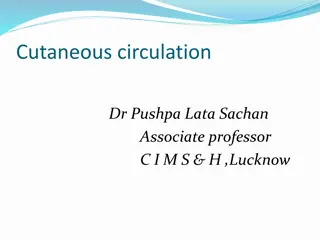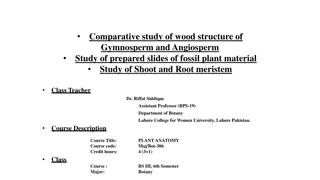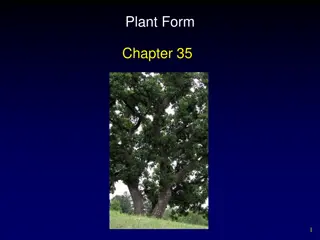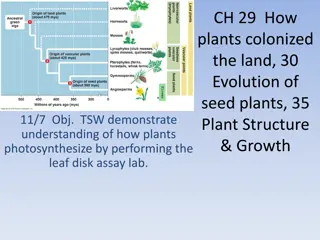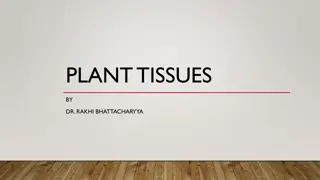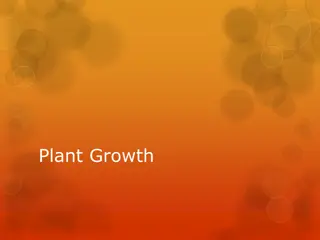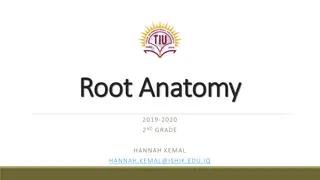Understanding Plant Growth Regulators: Phytohormones and Their Functions
Plant growth regulators, also known as phytohormones, are organic compounds produced naturally in plants to control growth and physiological functions. They include auxins, gibberellins, cytokinins, ethylene, growth regulators, and inhibitors. Auxins, for example, promote growth along the plant's lo
2 views • 28 slides
Understanding Cutaneous Circulation and Blood Supply in Different Body Regions
Cutaneous circulation plays a vital role in supplying blood to the skin, with variations in apical and non-apical regions of the body. The blood flow is regulated by neural, thermal, and metabolic factors, and controlled by sympathetic fibers. Sympathetic vasoconstriction and vasodilation affect the
0 views • 19 slides
Comparative Study of Wood Structure in Gymnosperms and Angiosperms
This course in Plant Anatomy at Lahore College for Women University delves into the detailed examination of wood structures in Gymnosperms and Angiosperms. It involves analyzing prepared slides of fossil plant material, studying shoot and root meristems, and understanding the differences between har
0 views • 9 slides
Understanding Plant Meristems and Growth Patterns
Explore the fascinating world of plant meristems, the small clumps of cells responsible for elongation of roots and shoots, as well as the different types of primary meristems and their roles in plant growth. Learn about apical and lateral meristems, primary tissues, and the organization of the plan
0 views • 33 slides
Understanding Plant Hormones and Growth Regulators
Plant growth regulators, also known as plant hormones, play a crucial role in regulating growth and development in plants. They are organic compounds that act at low concentrations to promote, inhibit, or modify growth processes. The main plant hormones include auxins, cytokinins, gibberellins, absc
1 views • 40 slides
Understanding Plant Diversity through Evolutionary Traits
Explore the fascinating world of land plants' evolution, from their appearance in the Ordovician period to the development of key traits such as alternation of generations, sporangia, gametangia, apical meristem, and other adaptations enabling them to thrive on land. Discover how plants have adapted
0 views • 47 slides
Plant Growth Hormones and Defense Mechanisms: Understanding Plant Responses to the Environment
Plant growth hormones and defense mechanisms play crucial roles in how plants respond to environmental stimuli such as water, sunlight, gravity, and more. From auxins promoting cell growth to gibberellins stimulating flowering, this presentation educates on the intricacies of plant hormones and thei
1 views • 13 slides
Understanding Plant Evolution and Characteristics
Plants colonized land through various adaptations such as multicellularity and photosynthesis. They exhibit characteristics like chlorophyll, cellulose cell walls, and apical meristems. Plant evolution includes alternation of generations, with gametophytes and sporophytes undergoing meiosis and mito
0 views • 15 slides
Understanding Plant Tissues and Meristems in Botany
Plant tissues are groups of cells with similar structures and functions. They can be classified into meristematic, permanent, and secretory tissues. Meristems are regions of continuous cell division found in plant tips and cambium, essential for growth. Primary meristems are present from the embryo
0 views • 28 slides
Understanding Plant Cell Growth Mechanisms
Explore the fascinating world of plant cell growth with a focus on specialized cells like guard cells for gas exchange, meristematic cells for differentiation, and apical meristems for plant growth. Learn how stomata function to regulate water loss and support photosynthesis, and uncover the key pro
0 views • 17 slides
Understanding Plant Roots: Anatomy, Functions, and Types
Delve into the world of plant roots and explore their anatomy, functions, and different types such as taproot and fibrous root systems. Discover how roots absorb water and minerals, anchor plants in the ground, transport nutrients, and store food. Learn about the primary and secondary root structure
0 views • 13 slides

